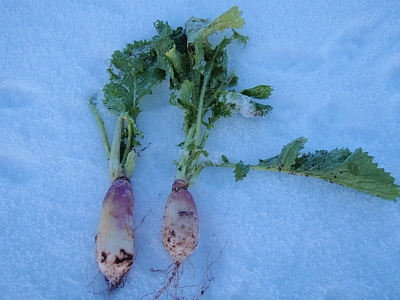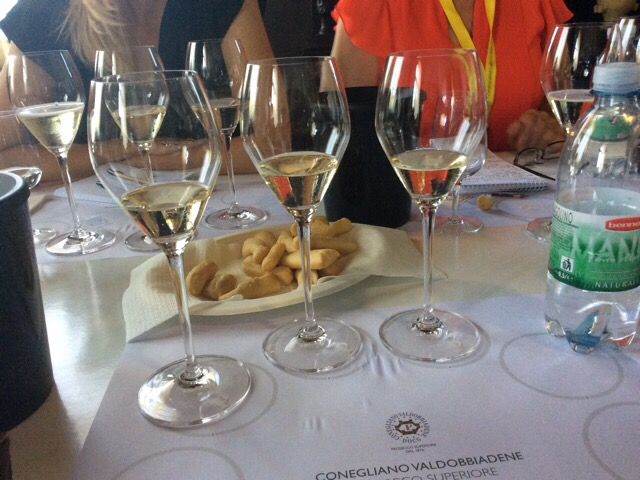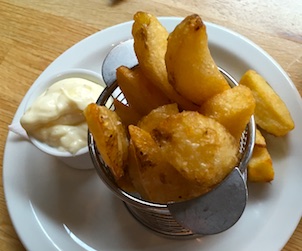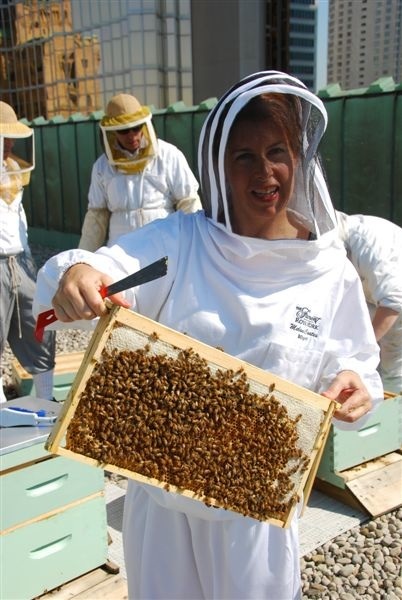by Malcolm Jolley
The brassica rapa gets no respect. Maybe it’s because turnips are the root vegetable that really aren’t root vegetables. Or maybe it’s because there are no readily memorable turnip dishes (think how many ways there are to create a dish of potatoes and contrast and compare). Or it could be that the prevalence of turnips in the early North American pioneer diet (they’re easy to grow and full of vitamin C) have turned off subsequent generations, as though our ancestors ate enough for all time to come. I am not sure I knowingly had a turnip until I was over the age of majority and ,even then, I had to investigate exactly what I’d eaten: what were those crunchy pink pickles mixed into the filling of a shish-taouk sandwich from the Lebanese pita shops of Montreal (they can also be found in discerning shwarma shops in Toronto and beyond)? Died pink by the inclusion of a beet in the brine my undergrad friends and I couldn’t figure out what the tangy, earthy little cubes were until our friend Rebecca, had the brilliant idea of simply asking the gentleman behind the counter. On that snowy night, just after last call, began my love affair with the turnip and I have sought them out, and sought to bring them back from obscurity, ever since.
More than some years later, I found myself at the beginning of another snowy night with turnips on my mind. Thousands of turnips, to be exact, all under foot in a large field on the top of a wide valley in mid-Wales. I had come to Wales, with my wife and children, to spend Christmas at Bill and Nancy’s place near Builth Wells, just north of the Brecon Beacons. Bill is my father –in-law and Nancy is his wife. Among the interesting things they do respectively and together is run an organic lavender farm (www.welshlavender.com), but you wouldn’t have known it this December and early January. Everything around their stone house, and in all the surrounding hills was covered in white snow, including Nancy’s lavender bushes. There was so much snow that the single track, hedgerow lined road leading to town was impassable. We were snowed in, with little to do in the short daylight hours but go tobogganing and take long walks in the up and down the slopes of the valley and up on the moors. On one of these walks with my wife, on a large hill farmer’s field I noticed something odd underfoot. Whatever was under the inch and a half of snow wasn’t grass, it was crunchy. A little digging revealed a great big, untouched field of long pink bottomed turnips, with great bushes of greens protruding. I filled my oil skin Barbour coat pockets with as many as I could fit and shouted at Apple, who was by now several hundred feet ahead of me, that we’d better high tail it back home before we got caught.
If tunips are not well respected in Canada, then it appears that they are even less respected in the sheep farming regions of Wales (which is to say in Wales). Rob, our neighbour in the valley, hadn’t planted those 10 acres of turnips because, like me, he loved them and thought the world supply ought to be augmented for gastronomic reasons. He planted that field to feed his sheep. Dotted among the grassy fields in Great Britain are field like his planted with turnips or what they call “Swedes” and I call Rutabagas. These hearty winter crops provide sheep with calories and vitamins when cold weather retards the growth of the grass. To be honest, I knew this, since I have walked over eaten fields of turnips in the years before. But this time I had actually beat the sheep! It was imperative that I grab the turnips before Little Bo Peep beat me to it. There was no time for niceties like asking permission (which when sought after later with a confession was given), it was time gather. Then it was time to cook.
The Romans, who considered the turnip a peasant food (again, no respect), cooked them simply enough by tossing them into the coals of a fire, and peeling them after. The turnips I gathered were so fresh and still young, that peeling was unnecessary and I simply cut them up, doused them in olive oil and let them roast in a hot oven for about half an hour. They were delicious. The leaves served as a green: cimi di rapa. Fans of the River Café cookbook series may recognise the name of that mysterious Italian vegetable Ruth Rogers and Rose Gray go to lengths to praise, without ever revealing exactly what they are. I assumed they meant a baby sort of rapini. Not until I read Anna Del Conte did I realise they simply meant turnip tops. I cooked my tops like I might any other winter green: sautéed in olive oil with garlic and chilli. A squeeze of lemon and a drizzle more of oil to finish. Delicious: the earthiness of the turnip bulb comes through the sharp chlorophyll freshness. Such are the wages of sin.
Fun Turnip Facts:
The “root” part of a turnip is not a root, but a “bulbuous stem”. (Although, Harold McGee point out that the very end bit is technically the vegetable’s tap root, so it’s not a complete fallacy, just mostly.)
As a brassica, the turnip is actually a sort of cabbage.
Experts trace the vegetable’s origins to Northern Russia and Scandanavia, but by the Bronze Age it had spread well across Asia and the Middle East as well as Europe.
Jacques Cartier is reported to be the first European to plan turnips in the new world at Quebec.
Turnips are particularly suited to northern climes and can survive deep freezes.
Malcolm Jolley is the editor of Good Food Revolution.









